Diamond Beach in Iceland

Welcome to Diamond Beach: Where Ice Meets Fire… and Black Sand
Looking for that jaw-dropping, Instagram-worthy spot in Iceland that’ll leave your friends wondering if you photoshopped it? Look no further – Diamond Beach has your back.
This isn’t just another pretty place; it’s a surreal mix of glittering icebergs, jet-black volcanic sand, and a vibe that screams, “Mother Nature outdid herself this time.”
Nestled just a stone’s throw from Route 1 (a.k.a. the famous Ring Road), Diamond Beach is ridiculously easy to reach with any of our trusty KuKu Campervans.
But let’s be clear: make sure you park in the lot! Unless, of course, you enjoy the idea of explaining to rescue services why your camper is chilling – literally – in a sea of ice blocks. No judgment here, but trust us, the beach is better explored on foot than from a sand trap.

Why is Diamond Beach So Unique?
Picture this: you step onto Diamond Beach, and suddenly, you’re convinced you’ve been teleported to another planet. No psychedelics required, just Iceland’s mind-blowing natural artistry.
First off, the sand.
It’s not your typical golden seaside fare. This is black sand, forged from molten lava and cooled by the icy Atlantic in a dramatic volcanic dance. Technically speaking, it’s basalt, but we prefer to call it nature’s way of flexing.
The sand’s dark tones are a stark reminder of Iceland’s fiery past, shaped by the volatile marriage of earth and fire.
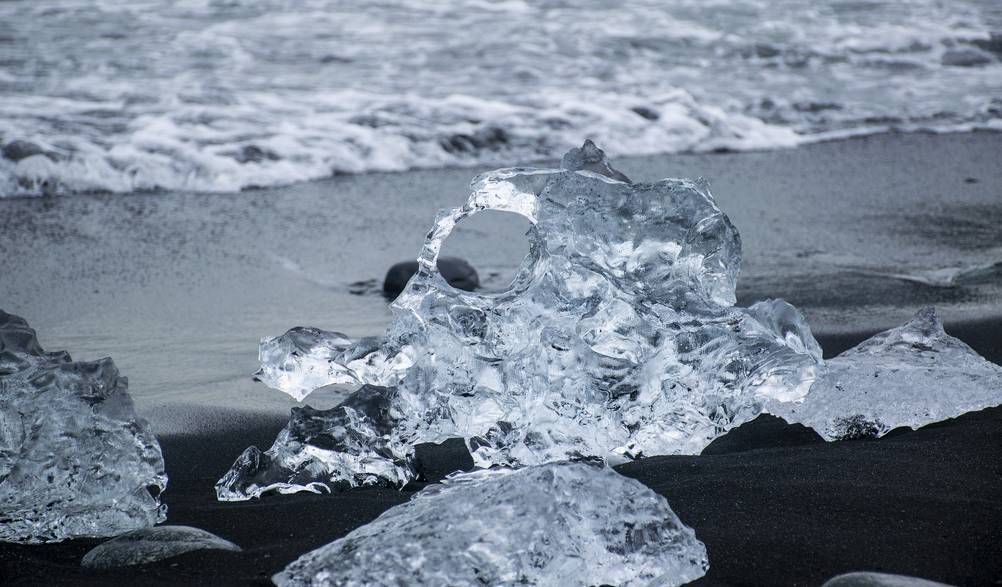
Sure, black sand beaches aren’t exclusive to Diamond Beach – you’ve probably heard of Reynisfjara, with its famous basalt columns and brooding waves. But Diamond Beach takes it up a notch with its signature accessory: ice chunks.
These glittering gems, courtesy of the nearby Jökulsárlón Glacier Lagoon, look like Mother Nature dumped her jewelry box right onto the shore. The contrast between the sparkling ice and the inky black sand... pure magic.
And when sunlight hits the ice? It’s a light show for the ages. Add crashing waves into the mix, and you’ve got a scene that photographers and Instagrammers dream of.
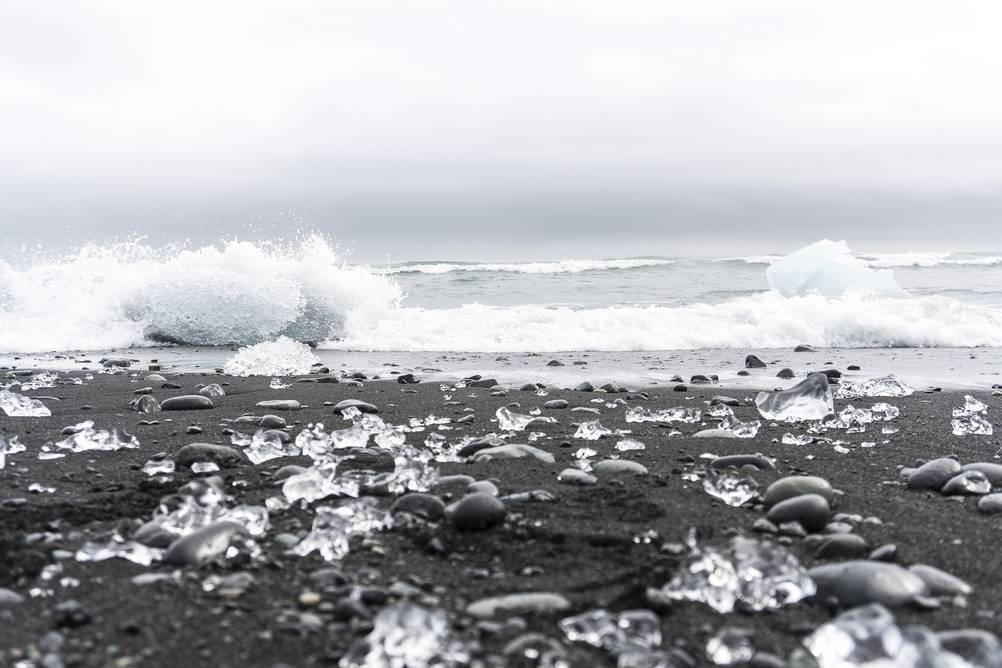 See those waves crashing on these big icebergs?
See those waves crashing on these big icebergs?
Oh, and the name?
While “Diamond Beach” does have a certain sparkle, it’s technically called Fellsfjara, part of the sprawling glacial plain known as Breiðamerkursandur. The catchy nickname was cooked up to lure travelers – and let’s face it, it worked.
After all, it’s much easier to remember “Diamond Beach” than to try pronouncing Icelandic tongue-twisters, isn't it?
So, what makes Diamond Beach so unique? A surreal blend of fire, ice, and creativity that’ll make you wonder if you’ve stepped into a fantasy novel.
Why Are There Blocks of Ice on Diamond Beach?
If you’ve ever wondered how a beach can look like a jewelry store display, the answer lies in one of nature’s most unique spectacles. And yes, it’s entirely natural – no special effects required.
 The beach is incredible during the sunset!
The beach is incredible during the sunset!
This phenomenon owes its existence to the famous Jökulsárlón Glacier Lagoon, a must-visit spot for anyone road-tripping through Iceland. Let’s break it down:
Jökulsárlón Glacier Lagoon: The Source of Diamond Beach’s Sparkle
Jökulsárlón is no ordinary lake. It’s a massive lagoon filled with floating icebergs, sourced directly from the Breiðamerkurjökull Glacier.
The lagoon itself is a bittersweet result of climate change; formed by glacial melt, it has grown to an impressive 18 km², now four times larger than it was in the 1970s.
At a depth of 248 meters (814 feet), it holds the title of Iceland’s deepest lake.
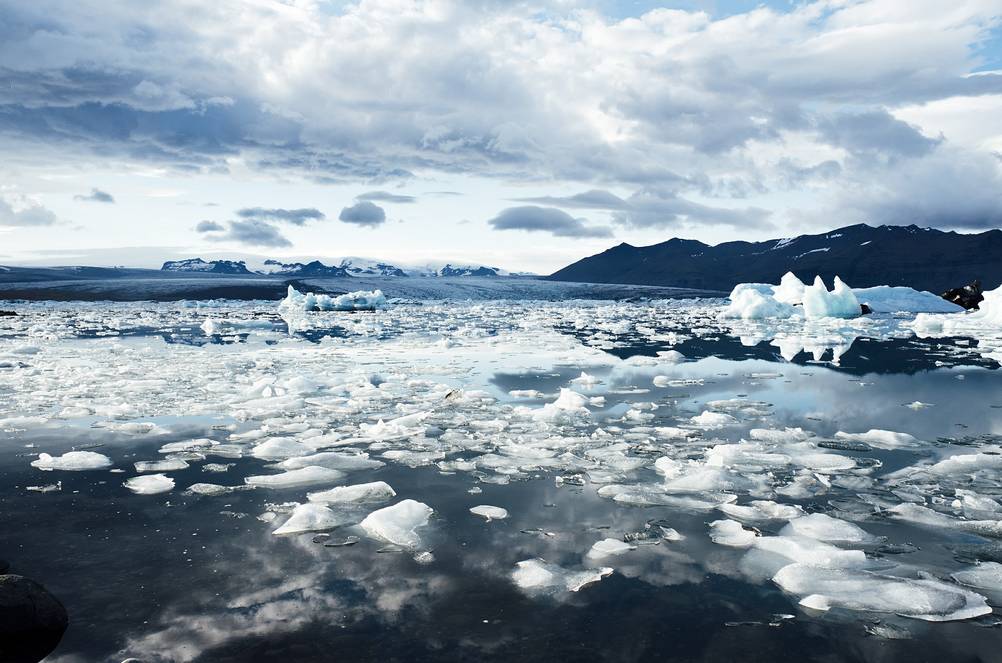
But here’s the silver lining: the lagoon has become a haven for wildlife, particularly seals. Winter is the best time to spot these playful creatures, as they gather closer to shore for a fish buffet.
So, if you’re dreaming of seal-watching, grab one of our heated KuKu campervans and head over during the colder months!
For those craving an even closer look, a boat tour on the lagoon is a great option.
You’ll glide past the icebergs, get up close to the glacier, and maybe even share a moment with a curious seal.
Tours usually last about an hour and start at about $75 – totally worth it for the views (and the bragging rights).
So, How Does the Ice End Up on the Beach?
Good question!
Jökulsárlón connects to the Atlantic Ocean through the Jökulsá River.
As water flows out of the lagoon, it carries chunks of floating ice along with it. These icy travelers eventually wash up on the black sands of Diamond Beach, creating the mesmerizing contrast that has made this place so iconic.
Whether it’s the story of the glacier, the seals, or the shimmering ice chunks, Diamond Beach is a testament to how even nature’s challenges can result in breathtaking beauty!
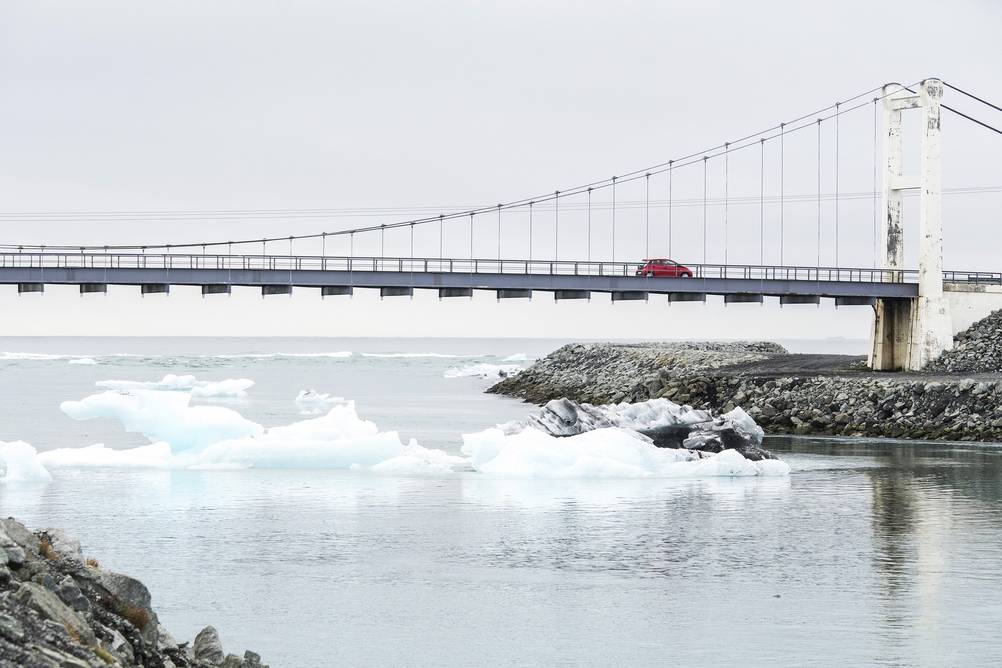
But here’s the thing: the water in Jökulsárlón Glacier Lagoon isn’t always following the same route.
During high tide, seawater flows into the lagoon, mixing with the freshwater from the glacier. This salty-freshwater cocktail is what gives the lagoon its stunning, otherworldly blue hues. Talk about a glacial glow-up!
Once the ice chunks leave the lagoon and hit the Atlantic Ocean, the real magic begins.
The waves and tides polish these icy travelers, smoothing their edges and giving them a crystalline brilliance. Eventually, the tide carries them back to shore, where they rest on the black sand like scattered diamonds – hence the name Diamond Beach.
And that’s really all there is to it. A simple yet mesmerizing process that turns a natural phenomenon into one of Iceland’s most iconic sights.
Who knew science and nature could make such a fabulous duo?
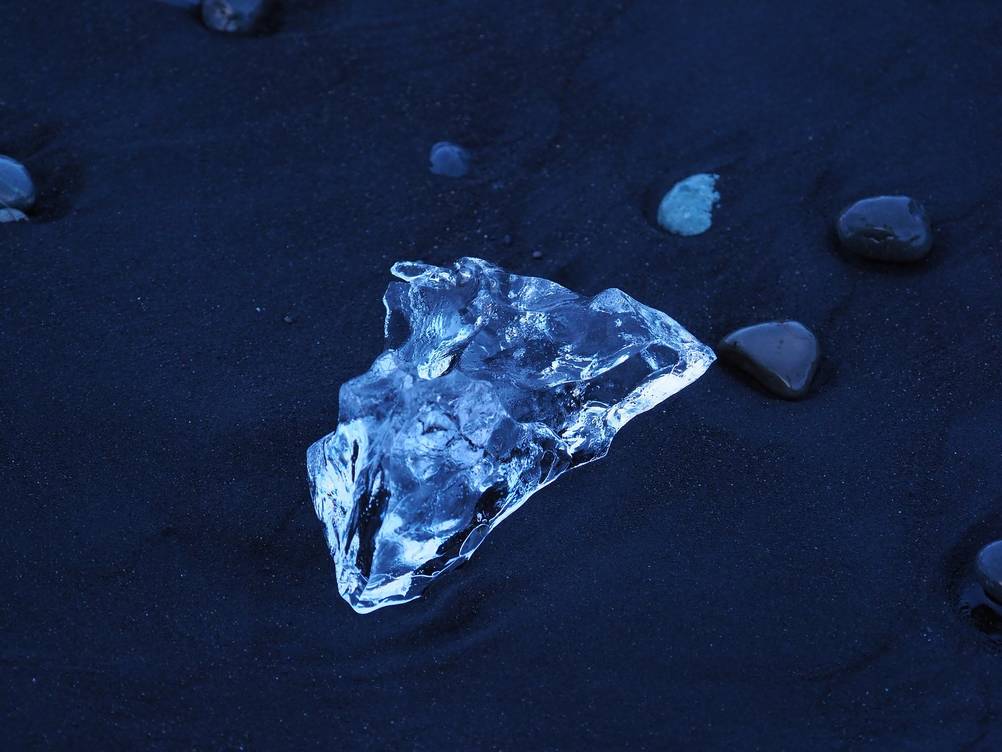
The Ever-Changing Landscape of Diamond Beach
The ice chunks at Diamond Beach are like nature’s own pop-up art installation – constantly evolving and never the same twice.
They range in size from tiny coin-like fragments to massive blocks as big as a car (or sometimes even bigger!). Their colors are equally mesmerizing, shifting between white, transparent, and the rare, striking blue. As for their shapes? Let’s just say they look like they were sculpted by a master artist. But nope, it’s all nature’s doing.
The magic of Diamond Beach lies in its constant transformation.
Melted ice chunks are always replaced by new arrivals, keeping the beach fresh and unique every time you visit. So, whether it’s your first trip or your fifth, you’re bound to be amazed – or, well, almost always.
Will There Always Be Ice Chunks?
Okay, let’s be real for a second.
While Diamond Beach is usually brimming with its icy “diamonds,” there’s a slim chance you might not see any during your visit.
Don’t panic – it’s just one of those Icelandic quirks. Think of it like going on a whale-watching tour and not spotting a single tail, or planning your perfect hike only to be met with sideways rain. Iceland loves to keep us on our toes.

That said, the odds are heavily in your favor.
Most of the time, the beach is scattered with dazzling ice chunks, waiting to leave you speechless. So don’t let the rare chance of an empty beach scare you off – Diamond Beach is still worth the trip, with or without its sparkly adornments.
Pro tip: Keep your camera ready, because when the diamonds are there, they’re an absolute showstopper.
When’s the Best Time to Visit Diamond Beach?
Honestly, any time is a good time to visit Diamond Beach: This place doesn’t have an “off-season.”
You might think summer’s too warm for ice chunks to hang around, but guess what? Iceland’s glaciers don’t melt that fast. Whether it’s summer or winter, you’ll still find those sparkling “diamonds” scattered along the black sand.
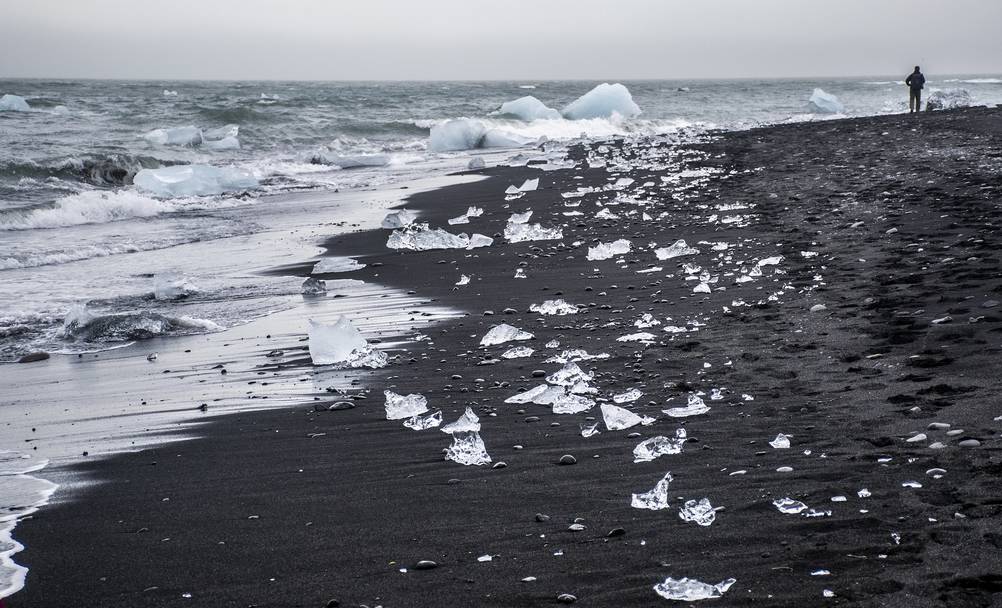
Summer vs. Winter
In summer, Iceland’s endless daylight gives you more hours to explore, snap photos, and soak in the scenery. Plus, the slightly warmer temperatures mean you’ll be a bit more comfortable while wandering the beach. Sure, ice melts a little faster, but not enough to make a real difference.
Winter, on the other hand, adds a touch of drama. The shorter days bring a magical twilight vibe, and if you’re lucky, you might even catch the Northern Lights dancing over the icy landscape.
The trade-off? Icelandic roads can be a challenge, with snow, ice, and strong winds keeping you on your toes. Summer driving, by comparison, is a breeze.
Safety First: Don’t Climb the Ice Chunks!
We get it. Those ice blocks look like the perfect Instagram backdrop. But trust us when we say: climbing them is a terrible idea. Here’s why:
- They’re slippery. One wrong step, and you’re on a fast track to a very painful fall.
- They’re unstable. Ice blocks can flip over, and if they’re in the water, you could get trapped underneath. Nobody wants to end up in a “tourist rescue” headline, right?
Iceland isn’t Disneyland – it’s raw, wild nature. So, admire the ice from a safe distance, and your visit will be unforgettable for all the right reasons.
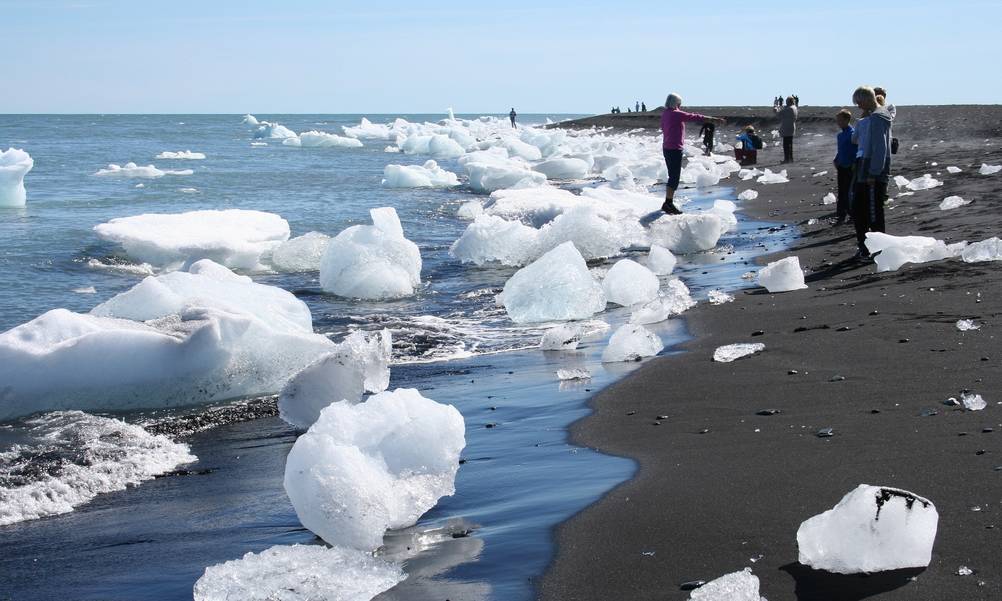 This is exactly what not to do here!
This is exactly what not to do here!
KuKu Tip: Dress for Success
The secret to staying comfortable at Diamond Beach?
Layers, layers, and more layers!
Waterproof and windproof clothing are non-negotiable. Trust us, battling Iceland’s weather is much more fun when you’re dry and warm.
No matter the season, Diamond Beach will leave you speechless (and probably a little windswept).
Just play it safe, dress smart, and get ready to make memories you’ll be bragging about for years!
How to Get to Diamond Beach in Iceland
Diamond Beach is a true gem (pun intended) located on Iceland’s stunning south coast, right next to the Jökulsárlón Glacier Lagoon.
It’s part of the Vatnajökull National Park, home to otherworldly landscapes like ice caves and towering glaciers. Here’s everything you need to know to find it.
Location & Directions
The beach is about a 5-hour drive from Reykjavik, straight along Route 1 (the Ring Road). It’s ridiculously easy to find – just look for the glacier lagoon on your left, and you’ll spot Diamond Beach on your right. Can’t miss it!
- Address: Þjóðvegur, Jökulsárlón, Iceland
- Pro Tip: Make sure your phone’s map app is downloaded for offline use. Cell service can be spotty in remote areas.
Where to Park
No parking stress here! There are two large parking lots, one near the beach and another by the glacier lagoon.
Even during peak season, finding a spot for your KuKu campervan shouldn’t be an issue.
Camping Near Diamond Beach in Iceland
Unfortunately, you can’t camp right on Diamond Beach (as cool as that would be). But fear not – there are excellent campgrounds nearby:
Svínafell Campground (50 km away)
Nestled at the foot of Öræfajökull Glacier, this campground is close to Skaftafell National Park. Facilities include:
- Cooking and dining areas
- Showers and restrooms
- Scenic views perfect for a quiet night
Skaftafell Campground (56 km away)
Situated within Vatnajökull National Park, this campground offers:
- Dedicated campervan spots with electricity
- Showers and restrooms
- A restaurant and laundry services
- Wi-Fi at the visitor center
- Numerous hiking trails to explore
Höfn Campground (78 km away)
For those heading further east, this campground offers:
- Electricity and cooking facilities
- Wi-Fi and laundry services
- Restrooms and a playground for kids

